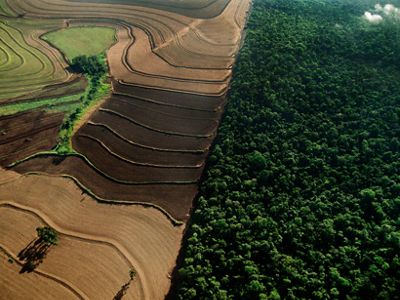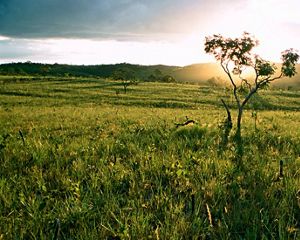
Written by Heather Zichal, Executive Director of the Blue Prosperity Coalition.
Recurrent flooding, drought, desertification, wildfires and melting permafrost: a report released last week by the Pentagon of the United States identified how these climate change impacts are a threat to national security. This report is the latest of many, most notably a special report by the Intergovernmental Panel on Climate Change, that highlight the urgent need for action on climate change.
With the World Economic Forum meeting happening in Davos, Switzerland this week, leaders from around the world are addressing the topic of climate change, among a host of other sustainable development issues. It’s an opportunity to raise awareness and deepen our commitment to sustainability by working together.
TNC has a long history working with a variety of partners to achieve our conservation goals, including the private sector. What makes our work with companies exciting is the limitless opportunity to do more.
Here are three trends in sustainability where business and nature can work together:
1. The financial community is increasing investments for environmental outcomes.

The value of nature is inherent in TNC’s conservation work. But matching financial investments to natural value projects has been a challenge for investment and insurance companies.
We’re starting to see breakthroughs. Bunge, a major soy trader, Santander Brasil and TNC are teaming up with farmers in the Brazilian Cerrado to offer long-term loans for projects that will increase productivity without expanding into natural habitat. In the meantime, along Mexico’s Yucatan peninsula, TNC and the Mexican government worked with Swiss Re to apply risk management modeling to develop an insurance mechanism to protect coral reefs. These investments simultaneously advance economic vitality and conservation, and they are examples of what’s to come.
Measurement of such investments is a topic gaining wider interest, as well. Environment, Society and Governance (ESG) has become a standard reporting framework for a number of companies, but we still lack consistency in how we measure and value different elements of an ESG framework. For example, how does a biodiversity initiative stack up against a commitment to reduce greenhouse gas emissions? These are complex questions, yet a better understanding of comparative impact could help direct future investment.
2. The connection between environmental and human health is growing.

What’s good for the planet is generally good for people too. And one of the ways we see conservation efforts gaining traction is through the connection to human wellbeing. Air quality, access to clean water, good nutrition—all of these issues speak to our relationship with nature. Last year, a group of scientists from TNC and other leading research institutions published “An Attainable Global Vision for Conservation and Human Well-Being,” an analysis that presents a pathway to a sustainable future in 2050. Their research explores the possibility of meeting the demands of increased populations and economic growth, while simultaneously advancing multiple conservation goals. It highlights how the environment, public health and sustainable development are linked, and how economic growth and environmental conservation—too often viewed as mutually exclusive—are interdependent.
These connections between public health, development, business and conservation communities are key to how we move forward. The Sustainable Development Goals (SDGs), which have been widely embraced by governments and companies, are helping break down the barriers between social and environmental issues. As more companies consider the SDGs in their sustainability programs, there is a common language to address how people and nature can thrive.
3. Zero-deforestation commitments are driving change…but the end goal is elusive.
A number of companies made commitments to eliminate deforestation in their supply chains by 2020. We may not reach that goal, but we’re moving in the right direction. In particular, we may see major developments in the Cerrado of Brazil this year.

Other trends to watch:
There’s no lack of sustainability challenges, so here are a few other areas where we companies are ramping up efforts:
- A greater focus on water: Efforts such as the CEO Water Mandate are drawing more attention to the importance of water security. TNC has developed water fund projects to protect watersheds in the Rio Grande in New Mexico, the Upper Tana in Kenya, and other places around the world to improve reliable access to clean water.
- More aggressive climate targets: More than 500 companies are taking a science-based approach to tackling climate change—and that number is growing. In a time of divisive politics, companies are taking more of a leadership role on climate action and we expect to see more ambitious goals in the coming year.
- Addressing plastic pollution: Plastic may improve our lives but it wreaks havoc on the environment. Plastic waste is in our oceans and watersheds and scientists are finding plastic debris in nearly every part of the world. It’s a problem we’ve created, and it’s a problem we can solve. It’s a positive sign that companies, including PepsiCo, Procter & Gamble, Dow, Danone, Unilever and The Coca-Cola Company, are banding together to work on solutions by investing in emerging technologies and infrastructure.
- The importance of the sustainability professional: Sustainability is becoming more central to way companies do business. It’s part of how they interact with customers, attract new talent and drive business results. Companies need people who can connect sustainability to the bottom line.
As more scientific studies and reports continue to show the challenges, it’s clearer than ever how we can take steps to live in balance with nature. And bringing conservation principles into the way we do business is one of the most important ways to drive change on a global scale.
Learn more about how we engage companies to adopt sustainable business practices.
Global Insights
Check out our latest thinking and real-world solutions to some of the most complex challenges facing people and the planet today.


